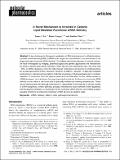| dc.contributor.author | Lu, James J. | |
| dc.contributor.author | Chen, Jianzhu | |
| dc.contributor.author | Langer, Robert S | |
| dc.date.accessioned | 2012-09-24T19:18:03Z | |
| dc.date.available | 2012-09-24T19:18:03Z | |
| dc.date.issued | 2011-03 | |
| dc.date.submitted | 2011-03 | |
| dc.identifier.issn | 1543-8384 | |
| dc.identifier.issn | 1543-8392 | |
| dc.identifier.uri | http://hdl.handle.net/1721.1/73132 | |
| dc.description.abstract | A key challenge for therapeutic application of RNA interference is to efficiently deliver synthetic small interfering RNAs (siRNAs) into target cells that will lead to the knockdown of the target transcript (functional siRNA delivery). To facilitate rational development of nonviral carriers, we have investigated by imaging, pharmacological and genetic approaches the mechanisms by which a cationic lipid carrier mediates siRNA delivery into mammalian cells. We show that 95% of siRNA lipoplexes enter the cells through endocytosis and persist in endolysosomes for a prolonged period of time. However, inhibition of clathrin-, caveolin-, or lipid-raft-mediated endocytosis or macropinocytosis fails to inhibit the knockdown of the target transcript. In contrast, depletion of cholesterol from the plasma membrane has little effect on the cellular uptake of siRNA lipoplexes, but it abolishes the target transcript knockdown. Furthermore, functional siRNA delivery occurs within a few hours and is gradually inhibited by lowering temperatures. These results demonstrate that although endocytosis is responsible for the majority of cellular uptake of siRNA lipoplexes, a minor pathway, probably mediated by fusion between siRNA lipoplexes and the plasma membrane, is responsible for the functional siRNA delivery. Our findings suggest possible directions for improving functional siRNA delivery by cationic lipids. | en_US |
| dc.description.sponsorship | National Institutes of Health (U.S.) (NIH Grant AI56267) | en_US |
| dc.description.sponsorship | National Institutes of Health (U.S.) (NIH Grant CA112967) | en_US |
| dc.description.sponsorship | National Institutes of Health (U.S.) (NIH Grant CA119349) | en_US |
| dc.description.sponsorship | Natural Sciences and Engineering Research Council of Canada (NSERC) (Post-doctoral fellowship) | en_US |
| dc.language.iso | en_US | |
| dc.publisher | American Chemical Society | en_US |
| dc.relation.isversionof | http://dx.doi.org/10.1021/mp900023v | en_US |
| dc.rights | Article is made available in accordance with the publisher's policy and may be subject to US copyright law. Please refer to the publisher's site for terms of use. | en_US |
| dc.source | ACS | en_US |
| dc.title | A Novel Mechanism Is Involved in Cationic Lipid-Mediated Functional siRNA Delivery | en_US |
| dc.type | Article | en_US |
| dc.identifier.citation | Lu, James J., Robert Langer, and Jianzhu Chen. “A Novel Mechanism Is Involved in Cationic Lipid-Mediated Functional siRNA Delivery.” Molecular Pharmaceutics 6.3 (2009): 763–771. Web. | en_US |
| dc.contributor.department | Massachusetts Institute of Technology. Department of Biological Engineering | en_US |
| dc.contributor.department | Massachusetts Institute of Technology. Department of Biology | en_US |
| dc.contributor.department | Massachusetts Institute of Technology. Department of Chemical Engineering | en_US |
| dc.contributor.department | Koch Institute for Integrative Cancer Research at MIT | en_US |
| dc.contributor.mitauthor | Chen, Jianzhu | |
| dc.contributor.mitauthor | Lu, James J. | |
| dc.contributor.mitauthor | Langer, Robert | |
| dc.relation.journal | Molecular Pharmaceutics | en_US |
| dc.eprint.version | Final published version | en_US |
| dc.type.uri | http://purl.org/eprint/type/JournalArticle | en_US |
| eprint.status | http://purl.org/eprint/status/PeerReviewed | en_US |
| dspace.orderedauthors | Lu, James J.; Langer, Robert; Chen, Jianzhu | en |
| dc.identifier.orcid | https://orcid.org/0000-0002-5687-6154 | |
| dc.identifier.orcid | https://orcid.org/0000-0003-4255-0492 | |
| mit.license | PUBLISHER_POLICY | en_US |
| mit.metadata.status | Complete | |
